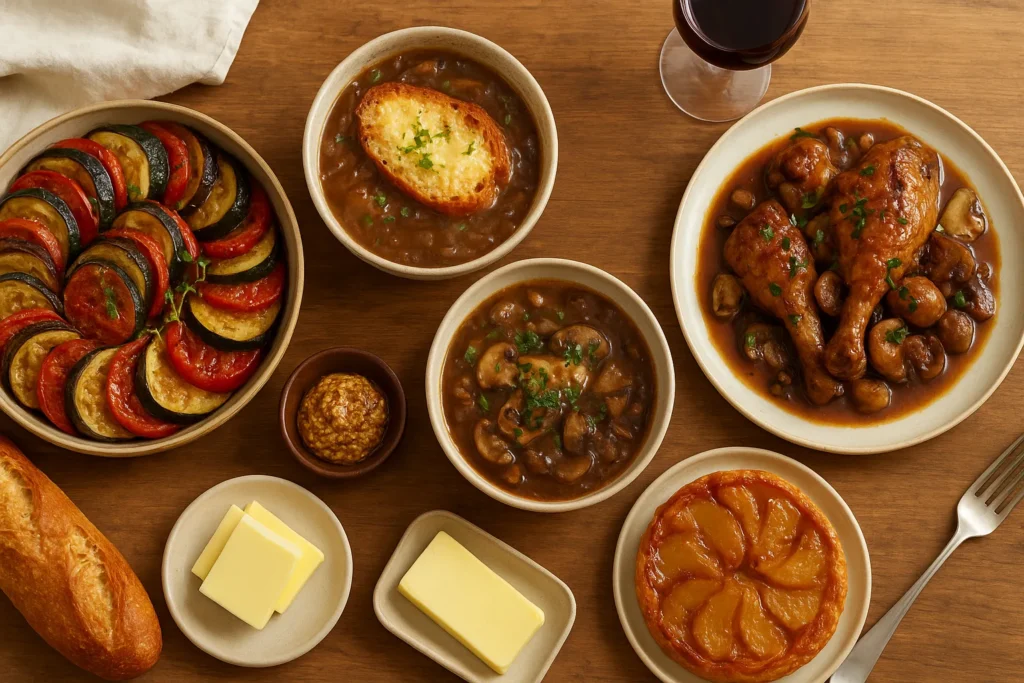
Ever wondered why French food has a reputation for being effortlessly elegant and irresistibly delicious? It’s not just the buttery croissants or the perfectly flaky pastries — it’s the French way of cooking: simple, flavorful, and full of passion. You don’t need to book a flight to Paris or wear a beret to enjoy authentic French flavors. With a few key ingredients, the right techniques, and a little joie de vivre, you can bring the magic of France straight into your kitchen!
1. The French Philosophy: Quality Over Quantity
French cooking isn’t about massive portions or complicated recipes — it’s about quality ingredients treated with care. The French know that a ripe tomato, fresh herbs, or good butter can make a dish shine. The goal? Let each ingredient tell its story.
So, when cooking French-style, skip the processed stuff. Instead, think fresh baguette, creamy brie, fragrant garlic, and golden olive oil. It’s not about how much you eat — it’s about savoring every bite like it’s a love letter to your taste buds.
2. Start with the Classics: Simplicity That Impresses
Let’s start with dishes that say “Bonjour!” to flavor but don’t require a culinary degree to make.
- Ratatouille – This colorful vegetable medley from Provence is as beautiful as it is tasty. Eggplant, zucchini, tomatoes, and bell peppers simmered in olive oil and herbs — it’s rustic, healthy, and packed with southern French sunshine.
- French Onion Soup – Slow-cooked onions caramelized to perfection in butter, swimming in a rich broth, and topped with a golden layer of melted cheese over toasted bread. Yes, it takes time, but it’s the kind of comfort food worth waiting for.
- Coq au Vin – Chicken braised in red wine with mushrooms, onions, and herbs. It sounds fancy, but it’s really just French for “delicious chicken stew that smells amazing while it cooks.”
These dishes showcase the heart of French cuisine — slow, thoughtful cooking that transforms simple ingredients into something extraordinary.
3. The Secret Weapon: French Sauces
Every French chef (and home cook) knows that a great sauce can turn any dish into a masterpiece. Whether it’s the creamy Béchamel, tangy Hollandaise, or red wine–infused Bordelaise, sauces are the soul of French cooking.
Here’s a quick example:
A plain piece of chicken is nice, but drizzle it with a Dijon mustard cream sauce, and suddenly it’s poulet à la moutarde. (Translation: your dinner just got a lot fancier.)
Pro tip: Learn one or two classic French sauces and use them to upgrade everyday meals. You’ll feel like a culinary genius in no time.
4. Baking Bliss: The Art of French Pastry
Ah, the world of French pastries — where butter reigns supreme and patience pays off. You don’t need to open a patisserie to enjoy authentic French sweets. Start simple!
- Madeleines – Little sponge cakes shaped like shells. They’re light, buttery, and perfect with tea or coffee.
- Crêpes – Think of them as France’s answer to pancakes — thin, delicate, and endlessly versatile. Fill them with Nutella for dessert or ham and cheese for a savory twist.
- Tarte Tatin – A caramelized upside-down apple tart that tastes like autumn in France. Sweet, sticky, and utterly irresistible.
French baking isn’t just about desserts — it’s a love language. The aroma of warm croissants fresh from the oven could melt even the iciest heart.
5. Wine and Cheese: The French Duo That Never Fails
Let’s be honest — French dining isn’t complete without wine and cheese. They’re like the dynamic duo of the culinary world. But the trick is pairing them right.
- A soft brie pairs beautifully with a glass of Chardonnay.
- A strong Roquefort loves a sweet Sauternes.
- And goat cheese? It practically flirts with Sauvignon Blanc.
Remember, there are no strict rules — only delicious discoveries. Experiment until you find your favorite pairing, and you’ll understand why the French never rush their meals.
6. The Joy of French Dining: Take Your Time
If there’s one thing the French take seriously, it’s mealtime. In France, eating isn’t just refueling — it’s a ritual. Meals are meant to be savored slowly, often over several courses (and sometimes several hours).
Try incorporating a little of that French rhythm into your life. Sit down, pour a glass of wine, turn off your phone, and really taste your food. It’s not just good for digestion — it’s good for the soul.
7. Your French Kitchen Starter Kit
You don’t need a chef’s toque or fancy copper pans to start cooking French food. A few staples will go a long way:
- Butter – Because everything tastes better with butter.
- Garlic and shallots – The aromatic foundation of countless dishes.
- Herbs de Provence – A magical blend of thyme, rosemary, and lavender.
- Wine (for cooking and sipping) – It’s essential, and yes, you can sip while you cook.
- Cheese – The more varieties, the merrier.
Equip your pantry with these, and you’ll be halfway to feeling like Julia Child in your own kitchen.
8. A Little Humor in Every Bite
Cooking French food doesn’t have to be intimidating. Sure, it sounds fancier in French — beurre blanc instead of “butter sauce” — but at the end of the day, it’s about joy. So what if your soufflé collapses? The French would just shrug, pour more wine, and call it rustic.
Cooking, like life, is meant to be enjoyed. And with French flavors, every meal becomes a small celebration.
